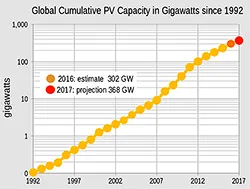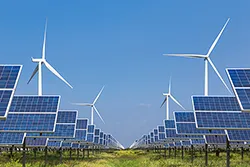Growth and profitability of photovoltaics far exceed forecasts
Better than all expectations: The potential of solar energy has been drastically underestimated for years - even in the models of climate researchers and the world climate survey. It was considered too expensive and too unreliable. However, photovoltaics is now one of the fastest growing renewable energies. By 2050, it could even cover 30 to 50 percent of the electricity demand worldwide, as researchers in the magazine "Nature Energy" forecast.

Boom for the sun: The development of photovoltaics has exceeded all forecasts worldwide. © Milos Muller/ thinkstockTo stop climate change, a switch to renewable energies is unavoidable, so much seems clear. But which energy forms bring the most advantages is far less clear. Although wind and solar energy are abundant in many places, the electricity generation from these sources varies greatly because they depend on the weather. The electricity grid must be capable of buffering these fluctuations, for example by forwarding them to other regions or by temporarily storing them in electricity storage.
But what is the potential of solar energy - also and precisely in view of these technical challenges? This is what Felix Creutzig from TU Berlin and his colleagues have now investigated. They have compared how well past forecasts are consistent with the actual development of photovoltaics and what conclusions can be drawn from the current situation on the future.
Faster increase than expected
The astonishing result: generating electricity from solar energy is much better than its reputation - and in almost every respect. It has grown significantly faster and its costs have declined faster than almost all models and scenarios have predicted. The IPCC estimated in the last world climate report that by 2015, a maximum of 50 terawatt hours would be generated by photovoltaics worldwide.
This is less than half of what has been produced globally by solar power in 2014, report Creutzig and his colleagues.
The International Energy Agency (IEA) predicted an annual growth of 16 to 30 percent, the German Environment Council (WBGU) estimated it to 26 percent and even Greenpeace saw the growth potential at a maximum of 24 to 32 percent. But current data shows:
With a growth rate of 40 percent per year, photovoltaics is the technology with the fastest increase among renewable energies, the researchers said.
Boom with private persons

Exponential growth: PV installed worldwide © free of chargeBut why was the solar energy so strongly underestimated? As the scientists explain, this is due to the misapprehension of three key factors: on the one hand, targeted support measures such as the Renewable Energy Sources Act and similar programs have been much better taken in other countries than they thought.
In Germany alone, this resulted in a 400-fold increase between 2000 and 2016, the researchers report.
With hardly anybody expecting, the boom in solar energy is especially due to individuals: the feed-in tariffs and subsidies made solar energy a worthwhile investment for them, and often the more favorable alternative to grid power.
At the end of 2012, 48 percent of the total installed photovoltaic capacity was owned by citizens - that's more than any other modern power generation technology, said Creutzig and his colleagues.
Steep "Learning curve"
The second decisive factor is the technical and price development of the modules:
With each doubling of the installed capacity, the costs for the solar cells have fallen by 22.5 per cent, the researchers report. This 'learning curve' is thus steeper than any other energy technology.
As a result, prices for "homemade" solar electricity are now in many places below the price of electricity from the grid. In countries like Dubai, Mexico, India or Chile, the solar power itself, without subsidies and funding, is already cheaper than the electricity from conventional power plants, as the scientists report. A third factor is the fact that the potential of competing energy forms has long been over-estimated.
And the impact on the power grid?
But the rapid increase in solar energy also has a shadow side: the higher the proportion of the solar current, the more the weather-induced fluctuations affect the electricity grids.
The first few percent can easily be handled by any power grid, the researchers said. However, with higher shares, the challenges for integration are becoming more and more apparent.
But experiences from countries with already high shares of wind and solar power show that there are quite profitable and feasible solutions as Creutzig and his colleagues explain. In addition to energy storage such as pumped storage or batteries, the expansion of the wiring systems and the supra-regional electricity exchange offerings can be buffered. Intelligent networks and better predictions also contribute to this.
Sun and wind as "Dreamteam"

The combination of photovoltaic and wind power could offset some fluctuations. © Soonthorn / FotoliaThe researchers see a particularly great potential in the combination of wind and solar energy:
In the EU, for example, photovoltaic production is highest during summer, while winds are blowing heavily in autumn and spring, they say. A combination of the two can therefore make the electricity generation more balanced.
The German Aerospace Center (DLR), who was not involved in the study, is similar to Karsten Lemmer:
We have calculated that about 60 percent of wind power generated by weather conditions and about 40 percent of solar energy is an optimum for Germany and the need for cost-intensive storage technologies is comparatively low.
Half of all electricity out of the sun?
Creutzig and his colleagues believe it is quite probable that by the year 2050, 30 to 50 percent of the electricity is generated from photovoltaics.
Even if one takes into account that the current requirement will be higher than today, the researchers said.
According to their estimates, photovoltaics could deliver 18,000 to 36,000 terawatt hours worldwide by 2050 - at a reasonable cost.
The researchers see particularly great opportunities in developing countries.
Many countries in the South have a cost-effective potential for solar energy that has remained largely unexploited so far, says Creutzig and his colleagues.
Money has been lacking, which is why targeted investment in photovoltaics in these countries could bring great progress. Think about investing...
Source:Nature Energy, 2017, doi: 10.1038 / nenergy.2017.140
